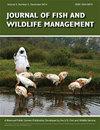Sampling duration and season recommendations for passive acoustic monitoring of bats after white-nose syndrome
IF 0.9
4区 环境科学与生态学
Q4 BIODIVERSITY CONSERVATION
引用次数: 0
Abstract
Since 2006, white-nose syndrome (WNS) has caused drastic declines in populations of several hibernating bat species throughout eastern North America. Thus, there is a growing need to establish long-term monitoring programs to assess changes in bat populations over time. Information on the seasonal timing of species occurrence and the sampling effort required to acoustically detect individual bat species and obtain complete inventories is needed to design and implement effective monitoring programs. From April through October in 2018-2021, we passively sampled for bats using full-spectrum detectors at eight permanent locations at Fort Indiantown Gap National Guard Training Center, Pennsylvania. We examined seasonal activity patterns and estimated bat species richness among detector locations and seasons using species accumulation curves. We also estimated probability of detection (p) and occupancy (Ψ) using single-season occupancy models in PRESENCE software, and then determined the number of sampling nights needed to reliably infer absence of each species. We identified 351,771 bat passes of eight species or species groups in 5,856 detector-nights. Seasonal patterns of activity varied among species. On average, approximately 30 sampling nights were needed to detect 90% of the total species richness among locations and seasons. Relatively few nights (≤12 nights) were needed to detect most species during summer, however, many more nights were needed to detect acoustically rare species. Our results indicate that the acoustic sampling effort currently required to determine presence or probable absence of federally endangered Indiana myotis Myotis sodalis and northern long-eared myotis M. septentrionalis may also be adequate for tri31 colored bats Perimyotis subflavus, but a greater level of effort may be needed for little brown myotis M. lucifugus in some areas. Monitoring programs that incorporate efficient sampling methodologies will be critical for future conservation efforts as populations of several bat species continue to decline.白鼻综合征后蝙蝠被动声学监测的采样持续时间和季节建议
自2006年以来,白鼻综合征(WNS)导致北美东部几种冬眠蝙蝠种群数量急剧下降。因此,越来越需要建立长期监测计划来评估蝙蝠种群随时间的变化。为了设计和实施有效的监测计划,需要了解物种发生的季节时间以及声学检测单个蝙蝠物种和获得完整清单所需的采样努力。从2018年4月到2021年10月,我们在宾夕法尼亚州印第安纳敦堡峡国民警卫队训练中心的八个永久地点使用全光谱探测器被动采样蝙蝠。利用物种积累曲线分析了不同季节和不同地点蝙蝠的季节活动模式和物种丰富度。我们还使用PRESENCE软件中的单季节占用模型估计了检测概率(p)和占用率(Ψ),然后确定可靠推断每种物种缺席所需的采样夜数。在5856个探测夜中,共鉴定出8个种或种群的351771个蝙蝠通道。不同物种的季节性活动模式不同。在不同地点和季节,平均大约需要30个采样夜才能检测到90%的物种丰富度。在夏季,对大多数物种的探测需要相对较少的夜晚(≤12个夜晚),而对声学稀有物种的探测则需要更多的夜晚。我们的研究结果表明,目前用于确定联邦濒危的印第安纳州肌炎和北方长耳肌炎是否存在的声学采样努力对于三色蝙蝠来说也足够了,但在某些地区可能需要更大的努力来确定小棕色肌炎。随着几种蝙蝠种群数量的持续下降,采用有效采样方法的监测程序对未来的保护工作至关重要。
本文章由计算机程序翻译,如有差异,请以英文原文为准。
求助全文
约1分钟内获得全文
求助全文
来源期刊

Journal of Fish and Wildlife Management
BIODIVERSITY CONSERVATION-ECOLOGY
CiteScore
1.60
自引率
0.00%
发文量
43
审稿时长
>12 weeks
期刊介绍:
Journal of Fish and Wildlife Management encourages submission of original, high quality, English-language scientific papers on the practical application and integration of science to conservation and management of native North American fish, wildlife, plants and their habitats in the following categories: Articles, Notes, Surveys and Issues and Perspectives. Papers that do not relate directly to native North American fish, wildlife plants or their habitats may be considered if they highlight species that are closely related to, or conservation issues that are germane to, those in North America.
 求助内容:
求助内容: 应助结果提醒方式:
应助结果提醒方式:


